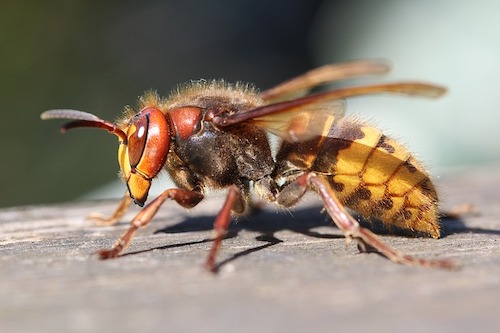(A hornet; photo: internet)
Once a man, probably a birdwatcher, when he heard I feed around twenty feral cats, said to me “They eat all the birds, you should be ashamed!” Well, I’m not. It is not that often that I see one of the cats (which I sterilize, and feed) play with a bird, and seldom do I find a heap of feathers, where a bird has been murdered.
It is said that when you feed cats, they stop hunting. Another misconception: I regularly see the cats fighting with, for example, a curling snake or a dangerous camel spider. But they let the hungry fox eat with them, also the cheeky hooded crows, though the latter are just barely tolerated.
No sir, the cats and I live in an enormous aviary and, in fact, I wouldn’t mind having a birdwatcher pay me a visit in order to make a list of all that flies around here. I know the ‘classics’: sparrow, finch, swallow, robin, blackbird, seagull, bee-eater, pigeon, hooded crow, jay, but that is only the basic core. There are a lot more birds singing in the trees around my house, from very teeny tiny ones to majestic birds of prey that, from on high, keep an eye on everything. I think I may have more kind of birds flying around here than there are cats to feed.
I love to hear the birds chattering, but they sometimes can also be annoying. Once there came a loud group, fancy coloured birds that with their wild parties in the olive trees kept me distracted from my work. No idea what they were — until a friend came to visit me with his son. This little boy held his telephone up in the air to catch the party sounds and ‘hoppa’, they were identified by an app. Sorry, I have already forgotten the rare and difficult name — but each year those party goers do return.
Another time there was a small group of sparrow look-a-likes with little striped heads who thought I was a tree and whilst chirping loudly came speeding towards me. Only at the distance of a few centimeters did they realized their mistake and suddenly turned back; where from a safe distance they took a better look at me. I never saw them again, let alone identified them.
Lately I have been keeping an eye on a swarm of pigeons, that frantically look for seeds on the field, before returning to the popular electricity wires where they settle neatly in a row to do some meditation. They are grey doves, like in the city. I am sure they are not holidaymakers or french fry eating city pigeons, but wild pigeons living on seeds and fruit. As far as I can see no laughing doves (Streptopelia senegalensis), like the one in Loutra (Lesvos). Even if that were the case, I would never let you know, because then there is a risk that an army of people armed with huge cameras with canon-long lenses will besieging the house.
Some days ago I saw a beautiful black and white dove rocking on the electricity wire at a certain distance from the group. It looked like she was being ‘othered’: she wasn’t admitted when the flock elegantly dived into the field. The next day she was gone. It could have been a black & white Afghan dove, maybe a refugee. Or it was a messenger from a friend and pigeon fancier from Friesland (Holland). Although no message was delivered. There also is a peace pigeon in the group: totally white. But that beauty seems to be integrated and is probably not rare.
Pigeons and other birds sometimes eat insects. Although I wouldn’t blame them for the shortage of mosquitos and wasps this summer. Now that the grapes and figs are over ripe, just a handful of hornets (Vespa) have appeared. But the normal wasp (in other years keen on nestling close to my front door) seems to have completely disappeared from my garden.
The world already is so upset this summer, with wildfires, storms and now part of Greece is flooded. These are all big disasters and it indeed seems like nature is taking revenge, now that humanity is so eagerly destroying the earth. The absence around my house of mosquitos and wasps could be another but silent ecological disaster. Or it might be because of the long heat wave, or you could blame the birds. In any case not the cats.











